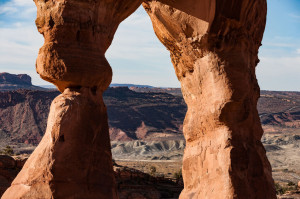At McNeil Engineering we employ civil engineers who happily take on any kind of infrastructure construction idea or challenge they can. However, we might argue that bridges are a civil engineer’s bread and butter. Bridges are impressive feats of engineering, it takes an incredible amount of knowledge, research, and math to create a bridge between two landmasses that can not only hold itself up, but can maintain constant daily travel by cars, people, and any weather condition imaginable.
So many of the world’s most popular and breathtaking travel destinations are bridges, like the Golden Gate Bridge in San Francisco or the Tower Bridge in London, England. In Utah, we have famous bridges like the Hite Crossing Bridge, a beautiful steel structure peaking over the Colorado River that cuts through miles of rocky red desert that feels like another world.
However, like all wonderful structures humans have created, the earth created her version first. Built without hard hats or penciled equations, Utah is home to some of the most beautiful and impressive natural bridges in the world. Each period of time throughout humanity is marked with its prominent architectural style (modern, gothic), but the natural bridge represents architecture that transcends both time and humanity and serves as a wonderful example of structural engineering, and an elegant first-hand reference to modern engineers as to how a structure can truly stand the test of time. Natural bridges are one of the best ways to observe not only what makes a bridge sturdy but also how natural environmental occurrences can effect and erode a bridge!
So why are we at McNeil Engineering bringing you this information on natural bridges, other than the fact that they are very cool? The natural bridges at this incredible monument stand as a symbol for how the engineers on our team can learn from nature and use that learned information to expand infrastructure in a way that is beautiful, respectful to nature, and structurally sound.
Our three most famous natural bridges in Utah are all contained within the Natural Bridges National Monument in San Juan County. This national park includes the 13th largest natural bridge in the world, the Sipapu, which spans 255 feet. This information was actually discovered by laser scanning, which is a form of land surveying that uses laser beams to collect accurate measurements and information for landscapes and landmasses. At McNeil, we employ people who specialize in laser scanning so that we assist clients in surveying land and structures accurately. Also, we think laser scanning is a massive leap forward in learning more from the structure of nature.
We’ve talked a lot about how engineers can learn from nature, and how it can be an essential practice for all types of engineers. However, that definitely doesn’t mean we think structural, or landscape engineering experts should just copy nature’s homework. No, one of the amazing things about learning from nature is that we can see things we might want to do differently. Firstly, natural bridges are created by water flow over thousands of years, and if we want to get from one landmass to another, we don’t have time to wait that long, we instead have to build our own.
While we can learn so much from the height and angles of natural bridges and how certain leverage can make a large amount of rock seem to defy gravity, we can also see where the bridge has natural eroded that will eventually succumb to that gravitational pull, and we’ll unfortunately no longer have it anymore. Obviously, if hundreds or thousands of people are depending on a bridge for transportation in order to work or see their families, we can sit back and say, “oh won’t that be a bummer when it erodes and collapses.” Modern engineers can study the areas where these natural bridges erode and their materials to then create a bridge using all of nature’s wonderful inspiration that we can depend on forever.
Finally, natural bridges are a great symbol of the work we do at McNeil Engineering because of our commitment to landscape architecture. In case you’re unaware, landscape architects focus on both development of man-made structures and the protection of natural structures. It can be incredibly difficult to do any sort of construction, landscaping, or infrastructure growth project knowing the damaging environmental impact your project could make.
We truly believe that, at this point, maintaining what natural environmental structures we have left are essential, but we also know that growth is a natural part of humanity. So, at McNeil Engineering we specialize in building information modeling, laser scanning, and landscape architecture to be able to digitally plan building projects before ground is even broken so that we can plan to preserve as much of nature’s inherent structure as possible. We employ engineers who are prepared to tackle all kinds of projects armed with this mindset. And yes, that of course, includes bridges.









